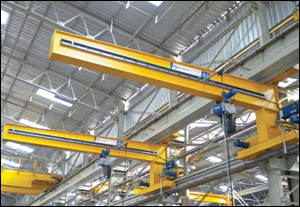
An upward trend
Speaking about the impact of the present economic slowdown, Manojit Acharya, Executive Director, Demag Cranes, had this to say: "We have seen the crane industry grow rapidly after the global slump in 2008. Various analytical estimates projected a growth rate of around 10 -12 per cent for the period 2010-15.However continued sluggishness in Europe and US is impacting growth. We have seen a flat investment scenario this year, in fact, dipping in many segments. Very recently, the volatile rupee too, has added to industry woes. The rupee depreciation impacts all manufacturers that rely on imports. We believe in being engaged with our customers at all times and steps in this direction, by way of localisation or other measures, have helped us tide over a part of the problem."
Says Saeesh Nevrekar, Country Manager, WMI Konecranes India, "The present economic condition has slowed down decision-making across some sectors. Industrial cranes are basically a very important and crucial capital investment for companies and the performance of the crane adds great value in productivity. These are the vital part of any production process. So, we expect 2013-14 to see an improvement for the material handling industry as there is substantial scope for the growth of the infrastructure sector viz., roads, steel, coal, cement, power, etc. The continuing investments in these sectors will support demand of material handling products. Also, with increased need of mechanisation and shrinking timelines of infrastructures projects, the demand for equipment should see a definitive upward trend."
According to Saeesh, the demand for high quality cranes with advanced technology is increasing in India. Customers are now recognising that cranes are the important part of their manufacturing processes and they would like to invest in good quality cranes which have the lowest lifecycle costs in the long run.
Speaking on the overall demand-supply scenario for industrial cranes from the various verticals, Acharya said, "There is no supply-side constraint in the area of EOT cranes in the material handling segment, except when the requirement is for very large capacity cranes say above a hundred tonnes or so, which can then be catered to by just a few manufacturers. The segments generate the bulk of the demand and they provide a clue to the real trends in the market. The power generation sector has been in a trough for the past couple of years and this means lower requirement for cranes. Automobiles and auto ancillaries are experiencing lower sales and hence, production rates have slowed down, which also has impacted their growth plans. Large expansion plans or any greenfield projects that were announced in 2012, are now on hold or indefinitely delayed. This has had a cascading effect on many other industries that require cranes. Infrastructure-related requirements too, have been lower and this also impacts the construction equipment industry. Globally, we serve the transport and warehousing sectors that need cranes for handling material; however, the Indian markets have not yet matured to that level and requirements from these sectors are not very high."


 +91-22-24193000
+91-22-24193000 Subscriber@ASAPPinfoGlobal.com
Subscriber@ASAPPinfoGlobal.com